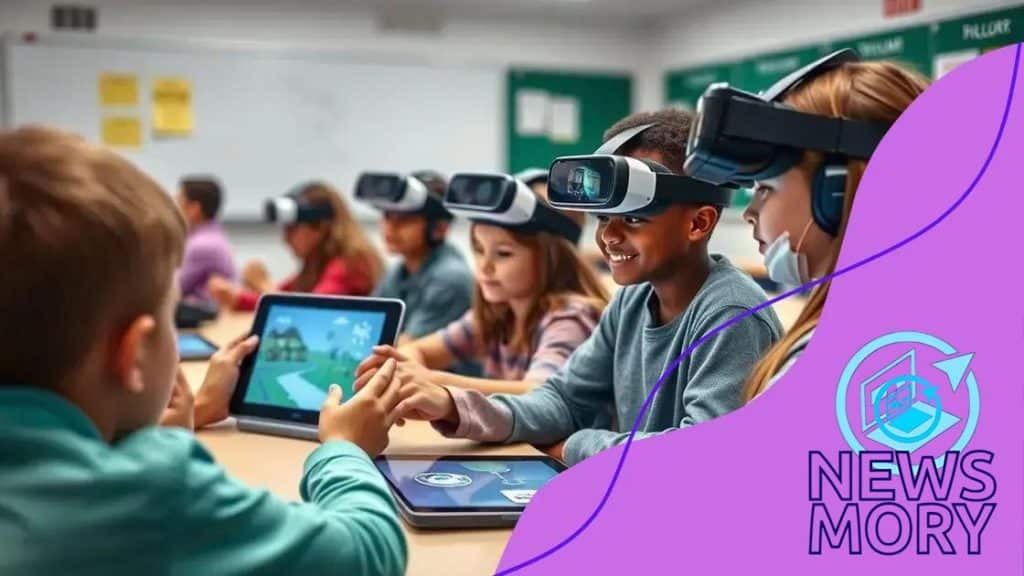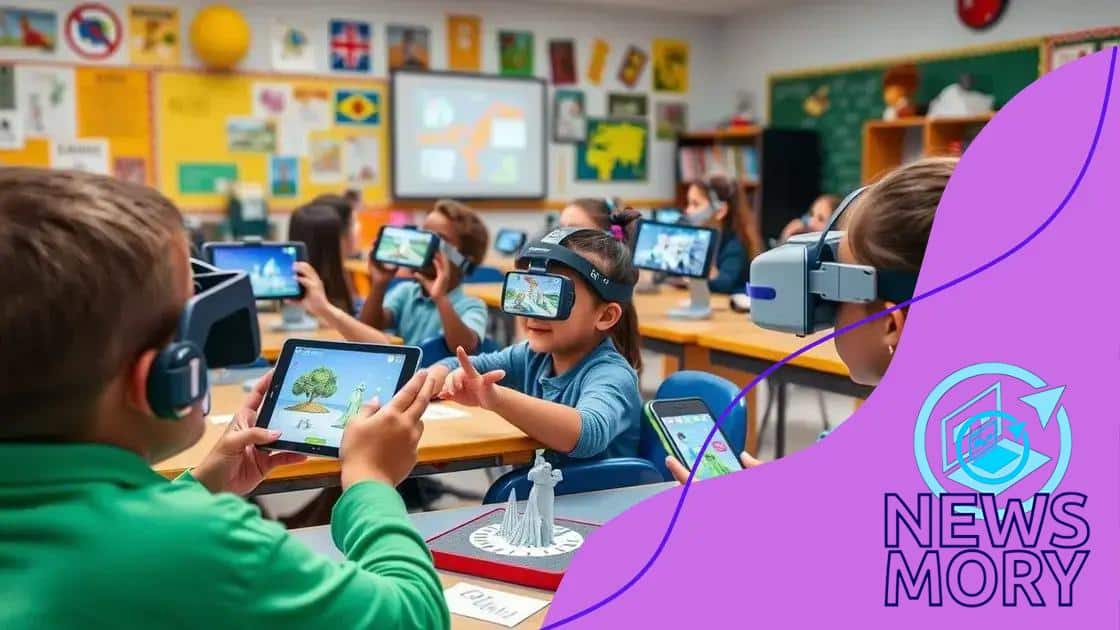How AR is being used for hands-on learning experiences

Anúncios
Augmented reality (AR) is transforming education by enhancing engagement, personalizing learning experiences, and fostering collaboration in classrooms through interactive and immersive learning opportunities.
How AR is being used for hands-on learning experiences is reshaping the educational landscape. Imagine exploring complex subjects right in your classroom through augmented reality. This technology offers immersive experiences that can make learning more engaging and practical.
Anúncios
Understanding augmented reality in education
Understanding augmented reality in education is essential for teachers and students alike. This technology blends the real world with digital components, opening doors to innovative learning experiences.
Augmented reality can transform traditional lessons into interactive adventures. Students can visualize complex concepts, making learning more engaging and effective. With AR, a history lesson can become a journey through ancient civilizations, while a science class might explore the human body in 3D.
Benefits of Augmented Reality in the Classroom
The use of AR in education provides several advantages:
Anúncios
- Enhanced Engagement: Students are more likely to participate in lessons that incorporate interactive technology.
- Practical Experience: AR allows for hands-on learning, helping students grasp difficult subjects through active exploration.
- Improved Retention: Engaging visual elements help students remember information better.
As education continues to evolve, augmented reality remains at the forefront of this transformation, encouraging creativity and collaboration among students. Teachers can utilize this technology to create unique learning environments that cater to various learning styles.
Incorporating AR into lessons also encourages teamwork. Students can work together to solve problems or complete projects, fostering communication skills. Furthermore, the instant feedback that AR provides helps learners adjust their approaches in real-time, leading to a deeper understanding of the material.
Real-Life Examples of AR in Education
Many schools and organizations are already harnessing the power of AR. For instance, applications allow students to view 3D models of planets or conduct virtual dissections. Projects like Google Expeditions enable students to take virtual field trips, exploring locations across the globe without leaving the classroom.
In conclusion, understanding augmented reality in education highlights its potential to create a dynamic learning atmosphere. With its interactive nature, AR not only engages students but also nurtures a deeper connection with the curriculum, paving the way for future innovations in teaching.
Benefits of AR for hands-on learning
Understanding the benefits of AR for hands-on learning can significantly enhance the educational experience. This technology provides students with unique ways to engage with material, making complex subjects easier to learn.
One of the primary advantages is that AR encourages active participation. When students interact with 3D models or simulations, they are more likely to remember what they learn. Unlike traditional methods, AR transforms passive learning into an immersive experience.
Key Advantages of Augmented Reality
Here are some key benefits of using AR in education:
- Enhanced Engagement: Students become more involved in lessons due to interactive and stimulating environments.
- Improved Understanding: AR helps to visualize difficult concepts which can lead to better comprehension.
- Increased Motivation: The novelty of AR can motivate students to participate actively in their learning process.
- Customizable Learning: Students can learn at their own pace, adjusting the experience to fit their needs.
Implementing AR in classrooms also promotes collaboration. Students can work together on projects, solving problems in real-time and sharing their insights. This teamwork helps build communication skills and camaraderie.
Moreover, AR can be tailored for various subjects, from science to art. For example, in a science class, students might explore the anatomy of a cell through an augmented reality app, allowing them to see details they would never grasp from a textbook. In art classes, students can learn about composition by manipulating virtual artworks in real-time. In each case, augmented reality acts as a bridge, linking theoretical knowledge to practical understanding.
In summary, the benefits of AR for hands-on learning are numerous. By fostering engagement, improving understanding, and encouraging collaboration, AR helps to create a richer educational experience. With technology evolving, its integration into education promises exciting possibilities for future learners.
Real-world applications of AR in classrooms

Real-world applications of AR in classrooms are transforming the way education is delivered. By incorporating augmented reality, educators create immersive environments that enhance the learning experience for students.
One popular use of AR is in science education. Students can use AR apps to explore the human body, visualize cellular structures, or even understand complex physics concepts. This hands-on approach helps solidify their understanding by allowing them to see and interact with subjects in a more engaging way.
Examples of AR Applications in Classrooms
There are several notable AR applications that educators are using:
- Google Expeditions: With this app, teachers can take students on virtual field trips to locations around the world, such as the Great Barrier Reef or the Egyptian pyramids.
- Merge Cube: This interactive tool allows students to hold and manipulate 3D objects, making abstract concepts in subjects like mathematics tangible.
- Anatomy 4D: An app that helps students learn about anatomy by allowing them to see and interact with 3D models of human organs and systems.
Another exciting application is in history lessons. Students can view historical events as if they are happening in real time, providing context that textbooks cannot convey. This way, they can better grasp the significance of key events and figures in history.
In art classes, students can explore famous artworks in 3D, learning about techniques and styles while able to see details up close. Through AR, they can even create their own digital art that can be visualized in the real world.
Advantages of Implementing AR
Implementing AR in the classroom offers numerous advantages. It not only makes learning fun and interactive but also caters to different learning styles. Visual learners benefit from seeing concepts brought to life, while kinesthetic learners enjoy hands-on experiences. This diversity in learning methods helps ensure that all students can connect with the material in a meaningful way.
Moreover, AR encourages teamwork and collaboration among students. Many AR applications allow for group activities where students must work together to complete tasks or projects, fostering communication skills.
Challenges of implementing AR technology
Implementing AR technology in classrooms presents various challenges that educators and institutions must navigate. While augmented reality offers exciting opportunities for enhanced learning, several factors can hinder its successful integration.
One major challenge is the cost of AR technology. Schools may face budget constraints that limit their ability to purchase the necessary devices and software. Ensuring that every student has access to this technology can be difficult, especially in underfunded districts.
Technical Challenges
Another challenge is the technical knowledge required to implement AR effectively. Teachers need training to understand how to use AR tools and integrate them into their lesson plans. Without proper training, they may struggle to harness the full potential of AR, leading to frustration and limited engagement.
Furthermore, connectivity issues can arise in classrooms. Many AR applications require a strong internet connection to function correctly. In areas with unstable internet access, using AR can become frustrating. These technical barriers can discourage teachers from adopting new technologies.
Content Availability
Beyond technical concerns, the availability of quality content can also be an issue. Not all subjects have robust AR applications available, meaning educators may have trouble finding resources that align with their curriculum. This limitation can hinder the effective use of AR in classrooms.
Additionally, there may be a resistance to change among educators and institutions. Traditional teaching methods have been deeply rooted in education, and some may be hesitant to adopt new technologies. This resistance can slow down the integration of AR and prevent students from benefiting.
Lastly, some students may experience challenges with AR based on their learning styles. While many students thrive in an interactive environment, others may find it overwhelming. Understanding how to support all learners when using AR technology is essential for educators to consider.
Future trends of AR in educational experiences
The future trends of AR in educational experiences are promising and full of potential. As technology continues to advance, AR will play an increasingly important role in how students learn and interact with information.
One major trend is the development of personalized learning experiences. With AR technology, lessons can be tailored to meet individual student needs, allowing learners to progress at their own pace. This customization helps ensure that each student grasps concepts effectively.
Integration with AI and Analytics
Another exciting trend is the integration of AR with artificial intelligence. This combination can create intelligent tutoring systems that adapt to students’ learning styles and provide real-time feedback. Such advancements will help further enhance the educational experience and support teachers in identifying areas where students may need additional help.
Data analytics will also play a role in shaping the future of AR in education. By analyzing how students engage with AR content, educators can gain insights into learning patterns. This information can guide the development of more effective instructional materials and strategies.
Collaborative Learning Environments
Future AR applications are expected to also foster more collaborative learning environments. Students will be able to work together in virtual spaces, regardless of their physical location. Imagine classrooms where students from different countries can participate in shared learning experiences, exploring topics together through AR-enhanced activities.
Additionally, the creation of AR communities will become more prominent. These communities will allow educators to share resources, lesson plans, and experiences, making it easier to implement AR technology effectively across various schools and districts.
Immersive Learning Experiences
The evolution of AR will also lead to more immersive learning experiences. As hardware becomes more affordable and accessible, students will be able to work with advanced headsets and devices that provide even richer interaction. For instance, history lessons may allow students to walk through ancient ruins or observe historical events unfolded as if they were present.
With these trends, augmented reality has the potential to radically shape the future of education. By embracing these innovations, educators can provide students with more engaging, interactive, and meaningful learning opportunities that prepare them for the challenges of tomorrow.
FAQ – Questions About Augmented Reality in Education
What are the main benefits of using AR in classrooms?
AR enhances student engagement, offers personalized learning experiences, and promotes collaboration among students.
How can teachers integrate AR into their lesson plans?
Teachers can use AR applications to create interactive lessons that allow students to visualize concepts, work with 3D models, and participate in virtual field trips.
What challenges do schools face when implementing AR technology?
Challenges include costs, the need for teacher training, technical issues like connectivity, and resistance to change from traditional teaching methods.
What does the future hold for AR in education?
The future includes more personalized learning experiences, advanced collaborations, and immersive environments that foster deeper understanding and engagement.





